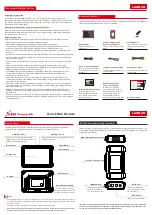
RSA-G2 Getting Started Guide
Page 38
Gas Pressure Specifications
Air should be supplied to the RSA-G2 at 283.2 L/min (10 scfm) at a pressure of 80 to 90 psi (0.55 to
0.6 MPa). Gas connected through the
N2/GAS
port should be supplied at 70 to 125 psi (0.48 to 0.86 MPa)
with a flow rate of 100 L/min.
Pressure to the various components should be preset to:
• Transducer:
40 psi (0.28 MPa)
• Motor:
40 psi (0.28 MPa)
• FCO heater air:
40 psi (0.28 MPa) with oven on.
Air Quality
It is critical that high quality, clean, dry air be supplied to the test station at all times. Any particles present
in the air must be smaller than 5 microns. Since the motor and transducer use air bearings, larger particles
in the air can easily damage the delicate high-precision bearing surfaces of these components. Damage to
the bearing surfaces may result in faulty measurements, and if significant enough, the damage may require
the replacement of the entire motor or transducer.
The dew point of the supplied air should be 10°C or lower. We highly recommend installing the optional
air dryer/filter between the test station and the air supply. If your air supply has excessive moisture levels
that result in the immediate condensation into water, a pre-air dryer system will be required. With air dryer
installed the dew point drops to below –10°C.
Because of the critical nature of the air supplied to the instrument, and the potential for expensive damage
through mishandling, we highly recommend that you inform your laboratory manager, or compressor
maintenance personnel, of your instrument requirements in detail. You should also ask to be informed
before any air supply interruption, or compressor maintenance, so that you can properly shut down and
protect the test station. Typically after any compressor maintenance, there will be some residual particu
-
lates and moisture present in the supply lines. You should disconnect the air from the test station input (or
air dryer) and purge the lines, before re-powering your instrument.
To quickly determine if there is an interruption in the air supply, we have found that it is helpful to install a
pressure gauge before the air dryer. An oil-less compressor system is recommended as well.
Making the Test Station Purge Connections
Follow these instructions to connect the oven and the RSA-G2 test station. Refer to
1
Locate the purge line going into the oven. Push this fitting into the port labeled
OVEN PURGE
. This
is an output line from the test station that provides purge air to the oven.
2
Locate the line going to the oven’s gun heaters. Connect this to the port labeled
GUN HEATERS
. This
is an outlet line from the test station to supply the oven with air or N2 gas.
3
Connect your laboratory air dryer to the test station at the
AIR
inlet port. This is an input line to the test
station that is used to supply air to the oven, motor, transducer air bearings, and throughout the test
station. Make sure the supply pressure is set at 80 to 90 psi (0.55 to 0.6 MPa).
Connecting the Signal Panel
The signal panel is the input/output interface for electrical signals entering and leaving the RSA-G2 test
station.
Summary of Contents for RSA-G2
Page 1: ......
Page 9: ...Forced Convection Oven with tension clamp Technology 8...
Page 13: ...IMMERSION TESTING I CLAMPING SYSTEMS...
Page 15: ...DETA I DIELECTRIC THERMAL ANALYSIS ACCESSORY DETA...
Page 29: ...tainstruments com 2019 TA Instruments All rights reserved L50027 001...
Page 30: ...Verso Filler Page z z...
Page 31: ...n getting Started guide Revision D Issued July 2022...
Page 99: ...Issued November 2013 Supplement to Getting Started Guide TA Instruments Manual Supplement...
Page 100: ...Page 2 TA Instruments Manual Supplement This page is intentionally blank...
Page 113: ...Page 1 Page 1 RSA G2 Solids Analyzer Revision G Issued May 2022 Site Preparation Guide...
















































